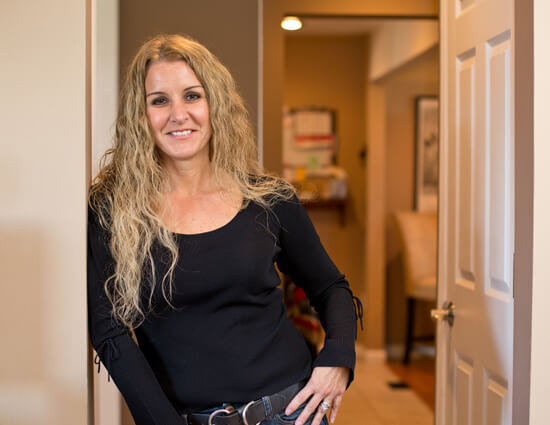“I would 100% recommend this to others. If I’d known how easy it would have been, I would have done it sooner”

Hysteroscopic ablation helps Hamilton mom return to her "normal"
The human body goes through many changes throughout a lifetime. Some changes
are generally universal, like losing baby teeth or growing taller. Other
changes are specific to an individual.
These nuances of our bodies are simply part of life, but for some, the
nuance can become more of a nuisance.
One in 10 Million
For many women, one of those changes can be related to the menstrual cycle.
What was once a precise and routine part of life can become unpredictable,
stressful and uncomfortable.
Approximately 10 million women are living with abnormally heavy bleeding,
or menorrhagia. This is considered bleeding that lasts longer than seven
days, or is very heavy in volume, often with accompanying blood clots.
Symptoms associated with menorrhagia can mean anything from an embarrassing
leak, to painful cramping and even anemia.
Renee, a Hamilton resident, was one of these women.
“I was always having cramps. I always felt bloated,” explains
Renee. “It kept me from doing things I wanted to do.”
Renee began experiencing symptoms after she had her third child. As the
symptoms became more and more troublesome, Renee brought it up to her
physician, Gary Brickner, MD, from the RWJ Center for Women’s Health.
Dr. Brickner mentioned the possibility of a procedure, but I didn’t
want to do it at first,” says Renee. “After years of these
symptoms, though, it came to a point where I said, ‘ok, I’ll
try it.’”
Why the Change?
“There are a number of reasons one might experience bleeding that
is heavier, or lasts longer than their previous normal,” explains
Gary Brickner, MD.
Some of the causes of abnormal bleeding include:
- Uterine fibroids—typically occurring during childbearing yearss
- Change in natural cycle
- Hormonal imbalance, particularly in estrogen and progesterone
- Miscarriage or ectopic pregnancy
- Use of blood thinners
- Problems with a non-hormonal intrauterine device (IUD) used for birth control
- Adenomyosis, a condition in which glands from the lining of the uterus become embedded in the muscular wall of the uterus
- Pelvic inflammatory disease
- Treatment options largely depend on the cause of the condition and how disruptive symptoms have become,” says Dr.Brickner.
Treatment for Menorrhagia
For some women, drug therapy such as birth control pills, or hormone therapy can help make periods more regular and reduce bleeding. For others, more invasive measures may be needed. Some procedures include:
- Dilation and curettage (D&C) – uterus lining is removed to reduce bleeding
- Operative hysteroscopy – a small camera gives the physician a view inside the uterus to remove polyps and fibroids or correct abnormalities and remove the lining
- Endometrial ablation or resection – all or part of the lining of the uterus is removed to control menstrual bleeding
- Hysterectomy; surgically removing the entire uterus
In Renee’s case, Dr. Brickner recommended hysteroscopic ablation,
a procedure for which the doctor uses a small camera—a hysteroscope—to
view inside the uterus and use an agent to heat the lining of the uterus
to slow or stop bleeding.
“For the right patient, this procedure provides significant relief
from heavy bleeding, without the need for major surgery, like hysterectomy,” he says.
According to Dr. Brickner, Renee was the ideal patient for the ablation
procedure because menopause was still far in her future, she was finished
having children and her menstrual cycle was regular.
“Procedures like this one have allowed us to cut down on the number
of hysterectomy surgeries we perform,” explains Dr. Brickner. “The
majority of patients experience a 50% reduction in flow, which is often
more than enough for a return to their normal.”
Since her procedure, Renee has had a 100% reduction in flow. To her pleasant
surprise, Renee is one of a small percentage of patients whose periods
stopped altogether, even though her body is not yet in menopause
“Dr. Brickner told me I might still get cramps after the procedure,
but I’m a rare case where there has been no after effect. No cramps.
No period. And no menopause,” says Renee.
“I would 100% recommend this to others. If I’d known how easy
it would have been, I would have done it sooner,” says Renee.